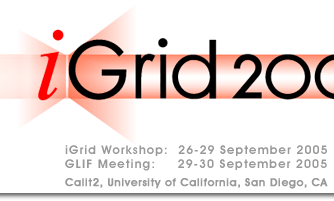CyberInfrastructure at the National Science Foundation
Jose L. Munoz, National Science Foundation, USA, jmunoz @ nsf.gov (ppt 9.7MB)
 rpvss.ucsd.edu:8080/ramgen/calit2/igrid/Tuesday/nsf/JoseMunoz.rm, 45:24
rpvss.ucsd.edu:8080/ramgen/calit2/igrid/Tuesday/nsf/JoseMunoz.rm, 45:24There is a growing awareness of cyberinfrastructure at the NSF and other USA agencies. Its increasing importance and visibility demands that cyberinfrastructure’s very complex inter-relationships be better understood, as well as its activities coordinated. What does the NSF mean by the term “cyberinfrastructure”? What’s “in” and what’s “out”? Which of its components is currently demanding our most attention and why? Where does the NSF foresee the future of cyberinfrastructure moving?
Greetings from iGrid 2005 to APAC’05
Larry Smarr, Calit2, USA, lsmarr @ ucsd.edu
iGrid 2005 host Larry Smarr broadcasts a warm welcome to the APAC’05 audience from San Diego, California, and then introduces the next iGrid speaker, Ian Foster, who broadcasts his keynote presentation on “Service-Oriented Science” from Queensland, Australia.
The ResearchChannel and University of Washington are using a specially designed HDTV broadcast system to transmit real-time presentations between the iGrid 2005 Workshop in San Diego and the APAC’05 (Australian Partnership for Advanced Computing) conference in Queensland, Australia. This is part of their iGrid demonstration “Global N-Way Interactive High-Definition Video Conferencing over Long-Pathway, High-Bandwidth Networks,” where a persistent setup between the two sites is in place.
How LambdaGrids are Transforming Science
Larry Smarr, Calit2, USA, lsmarr @ ucsd.edu (ppt 1.3MB)
 rpvss.ucsd.edu:8080/ramgen/calit2/igrid/Thursday/lambdagrids/LarrySmarr.rm, 10:56
rpvss.ucsd.edu:8080/ramgen/calit2/igrid/Thursday/lambdagrids/LarrySmarr.rm, 10:56The emergence of a global LambdaGrid cyberinfrastructure is transforming e-science from a bandwidth-constrained world to a bandwidth-rich world. Currently, most science is done locally in the end-user’s lab, with the only tightly coupled compute and storage systems being the lab’s cluster. Collaboration is largely sustained by physical visits and email or telephone calls. In this new LambdaGrid architecture, scientific data can be accessed anywhere in the world via LambdaRAM with less latency than if it were stored on a local hard disk! Furthermore, remote scientific instruments and collaborators appear to be in the next room. We see at iGrid a few pioneering researchers who are showing us how this transformed cyberinfrastructure allows them to carry out a new level of science, with persistent high-performance collaboration on a planetary scale, allowing global teams to interactively obtain, process and share vast amounts of distributed data. This presentation provides an early glimpse of a broad range of scientific research applications that a Service-Oriented LambdaGrid Cyberinfrastructure will enable.
Network Security and Optical Networks
Carter Bullard, QoSient LLC, USA, carter @ qosient.com (pdf 1.7MB)
This presentation describes current trends in data network security, and discusses how optical networking both supports and threatens these security strategies, suggesting that a more classic approach is needed. Practical issues in high-performance networking are motivating people to revisit the NSA’s “Red Book” approach to network security, and how this approach can affect the design and operation of optical networks, especially with regard to the optical control plane. The ultimate goal is to support a cycle that provides effective security threat identification, assessment, prevention and incident response.
Service-Oriented Architectures for Research and Education Networks
Bill St. Arnaud, CANARIE, Canada, bill.st.arnaud @ canarie.ca (ppt 5.5MB)
 rpvss.ucsd.edu:8080/ramgen/calit2/igrid/Tuesday/serviceoriented/BillStArnaud.rm, 36:20
rpvss.ucsd.edu:8080/ramgen/calit2/igrid/Tuesday/serviceoriented/BillStArnaud.rm, 36:20We may soon deploy Research and Education Services Networks (RESNs) that enable Web Services, based on Service-Oriented Architecture (SOA) standards, to be securely published, reused and invoked. CA*net 4 is a prototypical RESN, allowing end users to provision, manage and control the routing of their own lightpaths and/or Articulated Private Networks without having to signal or request services from a central network management authority or server. The next phase of this User Controlled LightPath (UCLP) software will seamlessly integrate large scientific instruments and sensors into the network using Web Services workflow and orchestration techniques. CANARIE has over a dozen SOA instrument/sensor/network projects under development; RESNs will seamlessly provide network “services,” from the optical network layer to the application layer, where every element is, in effect, a “LEGO”-like building block that end users can assemble in any configuration they choose. SOAs for networks complement many of the developments being undertaken in the USA cyberinfrastructure program.
Service-Oriented Science
Ian Foster, Argonne National Laboratory and University of Chicago, USA, foster @ mcs.anl.gov (ppt 6.6MB)
New information architectures enable new approaches to publishing and accessing valuable data and programs. So-called service-oriented architectures define standard interfaces and protocols that allow developers to encapsulate information tools as services which clients can access without knowledge of, or control over, their internal workings. Thus, tools formerly accessible only to the specialist can be made available to all; previously manual data processing and analysis tasks can be automated by having services access services. Such service-oriented approaches to science are already being applied successfully, in some cases at substantial scales, but much more effort is required before these approaches are applied routinely across many disciplines. Grid technologies can accelerate the development and adoption of service-oriented science by enabling a separation of concerns between discipline-specific content and domain-independent software and hardware infrastructure.
The ResearchChannel and University of Washington are using a specially designed HDTV broadcast system to transmit real-time presentations between the iGrid 2005 Workshop in San Diego and the APAC’05 (Australian Partnership for Advanced Computing) conference in Queensland, Australia. This is part of their iGrid demonstration “Global N-Way Interactive High-Definition Video Conferencing over Long-Pathway, High-Bandwidth Networks,” where a persistent setup between the two sites is in place.


